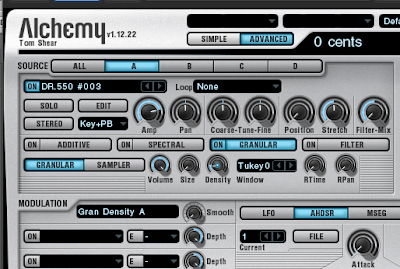
Although it's certainly not for everyone, there is no doubt that Camel Audio's Alchemy is one of those rare synths that really lives up to the hype that surrounds it. Although it does many things well, the area it is almost unparalleled in is its ability to mangle samples beyond recognition. While many people like to focus these abilities on evolving, organic pad sounds, most people underestimate its abilities to f up their existing drum samples into entirely new, modern sounds. Indeed, given enough time, you could easily create an entire library of new drum sounds for yourself, all sourced from sounds you already have on hand.
The key to getting started with this technique is to familiarize yourself with importing your own audio into Alchemy. Of course, Alchemy ships with a nicely varied range of source material already, but I've always found it more special to use your own to give yourself more unique sounds. The procedure for doing this is simple. Just click on the name of the waveform under the SOURCE section. This will bring up a menu with a number of options. Select "Import Audio" and a dialog box will open up allowing you to locate and and import the audio of your choice. Try importing a snare drum sample you like.
As you may already know, Alchemy has a number of different ways of analyzing and breaking down the audio that you feed it. Each has its own advantages and drawbacks, but more importantly, each also has its own type of artifacts that come out when abused. That there's your pathway to some unique sounds. Try out the different options (listed at the top of the import dialog): Granular, Additive, Additive + Spec, and Spectral. Once you've chosen a method and imported your sounds, select the SOURCE button at the top of the main page to select whichever source your just loaded your audio into. Try tweaking all the parameters on the source page to see how they change and twist the source material. As I said before, each method introduces its own artifacts when you tweak to extreme degrees, so go crazy.
You will quickly figure out that some methods are better than others for maintaining, say, the punch of a snare, than others. Whereas other methods might be great for smashing your sample up, but might not preserve the oomph you need. This is no problem, because we have access to 4 sources, so we can load different drum sounds (or even the same one) into each slot, each imported via its own method, with its own setting for pitch, pan, start position, stretch, etc etc. This is where you REALLY get into making interesting sounds. View each source as being used for its own component of a single drum sound. Be sure to mess around with pan position for some nice, wide stereo sounds, too.
This is plenty powerful in itself, but you can go even further if you like. Dive into the modulation abilities and try modulating some of those parameters with the step sequencer or multi-segment envelopes. Modulate the filter. Slap some effects on it and modulate the effects. Really interesting and complex effects are possible at this level that can really give your drum and percussion sounds that extra something to make them stand out.




















No comments:
Post a Comment